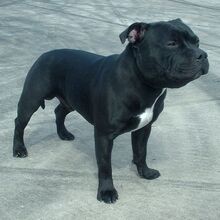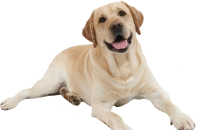
The Staffordshire Bull Terrier is a medium-sized, short-coated breed of dog. It is of English lineage, and is one of several breeds generally considered to be within the pit bull type.
History[]
Before the 19th century, bloodsports such as bull baiting, bear baiting and cock fighting were common. Bulls brought to market were set upon by dogs as a way of tenderizing the meat and providing entertainment for the spectators; and dog fights with bears, bulls and other animals were often organised as entertainment for both royalty and commoners.
Early Bull and Terriers were not bred to resemble the companion animals of today, but for the characteristic known as gameness, with the pitting of dogs against bear or bull and exotic animals testing this attribute along with the strength and skill of the dog. Landrace working dogs crossbred with bulldogs provided the ancestral foundation stock for the Staffordshire Bull Terrier. This ancestor is traditionally known as a "Bull Terrier", believed to be around 200 years old by the time of the early 21st century, and is rather a class of races than a particular breed.
These bloodsports were officially eliminated in 1835 as Britain began to introduce animal welfare laws. Since dogfights were cheaper to organise and far easier to conceal from the law than bull or bear baits, bloodsport proponents turned to pitting their dogs against each other instead. Dog fighting was used as both a bloodsport (often involving gambling) and a way to continue to test the quality of their stock. Clandestine dog fighting took place in pockets of Britain and America. Dogs were released into a pit, and the last dog still fighting (or occasionally, the last dog surviving) was recognised as the winner. The quality of pluckiness or "gameness" was highly prized; a dog that gave up during a fight was reviled as a cur.
As time went on the modern breed has become one with a temperament suitable for a pet and companion. It gained respectability, becoming a dog worthy to show, and was accepted by The Kennel Club of the United Kingdom as the Staffordshire Bull Terrier in 1935.
Breeding[]
The breed attained recognition by the Kennel Club on 25 May 1935. The Staffordshire Bull Terrier Club was formed in June 1935, one month after the breed was recognised by the Kennel Club. It is unusual for a breed to be recognised without a club in existence first, and even more unusual for there not to have been a breed standard in place. A standard was not drawn up until June 1935 at the Old Cross Guns, a Black Country pub in Cradley Heath in the West Midlands. A group of 30 Stafford enthusiasts gathered there and devised the standard, as well as electing the club's first secretary, Joseph Dunn, a well-known figure connected with the breed. Challenge certificates were awarded to the breed in 1938, and the first champions were Ch. Gentleman Jim (bred by Joseph Dunn) and Ch. Lady Eve (owned by Joseph Dunn), both taking titles in 1939. During the 1980s owners started to breed from old British lines also importing Staffordshire Bull Terriers from Ireland which they believed to be truer to the original of the pre showing days. These dogs are often referred to as Irish Staffordshire Bull Terriers. Media reports often refer to this as a cover name for breeders to sell pitbulls illegally.
The breed was recognised in the U.S. by the American Kennel Club in 1975.
Appearance[]
The Staffordshire Bull Terrier is a medium-sized, stocky, and very muscular dog, with a similar appearance to the much larger American Staffordshire Terrier and American Pit Bull Terrier. The coat is smooth and clings tightly to the body giving the dog a streamlined appearance. This dog has a broad, wedge-shaped head (male considerably more so than female), defined occipital muscles, a relatively short fore-face, dark round eyes and a wide mouth with a clean scissor-like bite (the top incisors slightly overlap the bottom incisors). The ears are small. The cheek muscles are very pronounced. The lips show no looseness. The teeth form a scissors bite. The head tapers down to a strong well-muscled neck and shoulders placed on squarely spaced forelimbs. They are tucked up in their loins and the last 1-2 ribs of the rib-cage are usually visible. The tail resembles an old fashioned pump handle. The hind quarters are well-muscled.
They are coloured brindle, black, red, fawn, blue, white, or any blending of these colours with white. White with any other colour broken up over the body is known as pied. Liver-coloured, black and tan dogs can occur but are rare and it is advised not to breed from either as well as those with light eyes. The exception to the light eye rule are Blue staffies; all others should have dark brown eyes even if fawn coat. The coat is smooth and clings tightly to the body giving the dog a streamlined appearance.
The dogs stand 36 to 41 cm (14 to 16 in) at the withers and weigh 13 to 17 kg (29 to 37 lb) for males; females are 11 to 15.4 kg (24 to 34 lb).
Temperament[]
Although individual differences in personality exist, common traits exist throughout the Staffords. Due to its breeding, and history, the Staffordshire Bull Terrier is known for its character of fearlessness and loyalty. This, coupled with its affection for its friends, its off-duty quietness and trustworthy stability, make it a foremost all-purpose dog.
The breed is naturally muscular and may appear intimidating; however, because of their natural fondness for people, most Staffords are temperamentally ill-suited for guard or attack-dog training. Staffordshire Bull Terrier puppies are very easy to house train.
Staffordshire Bull Terriers are friendly, enthusiastic and usually extremely affectionate towards humans. They express their affection through jumping up, nuzzling, licking and pawing, and even when trained can still be 'fussy' with owners and others. Staffordshires are perhaps not suitable pets for those who prefer more reserved dogs. Staffordshires are notably adaptable in terms of changing home or even owners, and unfortunately this can make them easy prey for dognappers.
RSPCA chief vet Mark Evans said: "Staffies have had a terrible press, but this is not of their own making—in fact they're wonderful dogs. If people think that Staffies have problems, they're looking at the wrong end of the dog lead! When well cared for and properly trained they can make brilliant companions. Our experience suggests that problems occur when bad owners exploit the Staffie's desire to please by training them to show aggression."
Breed-specific legislation[]
The Staffordshire Bull Terrier is subject to breed-specific legislation in various countries, which ban members of the Bull and Terrier family.
Health[]
Staffordshire Bull Terriers are known to suffer from Hereditary Cataracts (HC) and L-2-hydroxyglutaric aciduria (L2HGA)—a metabolic disorder resulting in behavioural changes and dementia-like symptoms—both of which are detectable via DNA tests.
Distichiasis (commonly known as “double eyelash”) and Persistent Hyperplastic Primary Vitreous (or PHPV)—a condition whereby the blood supply to the ocular lens fails to regress and fibrovascular tissue forms, causing hazy vision—both of which are checked by way of an ocular examination throughout the life of a breeding stud or brood-bitch to minimise the transfer and spread of these conditions.
The breed is known to be at a higher risk from mastocytoma (mast cell tumours) than the general population of dogs.
A UK Kennel Club survey puts the median lifespan at 12.75 years. UK vet clinic data puts the median at 10.7 years.
